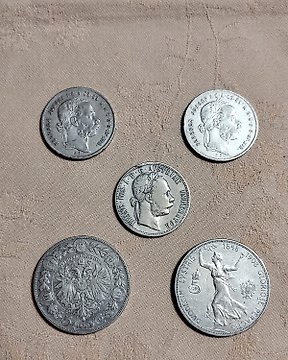
Austria. Collection of Habsburg coins
N.º 83459015

N.º 83459015

Must be seen. Large collection old European coins including over 40 (!) SILVER coins and 1/2 gram GOLD ingot. No reserve price (!) Please have a look at the pictures.
Interesting, varied collection "older" coins Europe starting from late medieval 1387 up to 1949 all 235 (!) coins in coin holders / slabs.
Amongst others:
* Russia including silver Ivan the Terrible (1547-1584) Wire Money and Nicolas II last Tsar of Russia
* Medieval Hungary Sigismund (1387-1437) silver Denar,
* UK including George IV, Victoria and several silver coins
* Jersey & Guernsey
* Switzerland including silver.
* Germany and France World War I Emergency coins,
* Vatican
* Belgium including Leopold II silver
* Norway, Denmark & Sweden including silver
* Austria including silver Franz Joseph (husband of Sisi),
* France including silver,
* Italy including silver Victorio Emanuele III
* RARE World War I Prisoner of war camp coin,
* Dutch provincial coins including silver,
* Portugal including silver,
* Netherlands (Kingdom) including silver,
* Germany including States Empire Weimar and Third Reich including silver coins up to 5 Mark (!),
* 1/2 Gram GOLD bar in card,
* approx 20% of the collection are SILVER coins
,……better dates, better qualities, , .... and many-many more.....
Please have a look at our other Catawiki auction lots for more coin collections. and/or add us to your favourites to find our future auction lots easily.
Bid with confidence. AG-Worldcoins, over 3000 lots sold on Catawiki. High feedback score.
Please evaluate this lot with reference to the images provided.
Will be sent via registered mail.
I charge only 1x shipping costs when you buy multiple lots in the same auction.
You are welcome to bid on my other items:
https://veiling.catawiki.nl/aanbod/hamaca
extra info:
The first early European modern humans appear in the fossil record about 48,000 years ago, during the Paleolithic Era. Settled agriculture marked the Neolithic Era, which spread slowly across Europe from southeast to the north and west. The later Neolithic period saw the introduction of early metallurgy and the use of copper-based tools and weapons, and the building of megalithic structures, as exemplified by Stonehenge. During the Indo-European migrations, Europe saw migrations from the east and southeast. The period known as classical antiquity began with the emergence of the city-states of ancient Greece. Later, the Roman Empire came to dominate the entire Mediterranean basin. The Migration Period of the Germanic people began in the late 4th century AD and made gradual incursions into various parts of the Roman Empire The Fall of the Western Roman Empire in AD 476 traditionally marks the start of the Middle Ages. While the Eastern Roman Empire would continue for another 1000 years, the former lands of the Western Empire would be fragmented into a number of different states. At the same time, the early Slavs began to become established as a distinct group in the central and eastern parts of Europe. The first great empire of the Middle Ages was the Frankish Empire of Charlemagne, while the Islamic conquest of Iberia established Al-Andalus. The Viking Age saw a second great migration of Norse peoples. Attempts to retake the Levant from the Muslim states that occupied it made the High Middle Ages the age of The Crusades, while the political system of feudalism came to its height. The Late Middle Ages were marked by large population declines, as Europe was threatened by the Bubonic Plague, as well as invasions by the Mongol peoples from the Eurasian Steppe. At the end of the Middle Ages, there was a transitional period, known as the Renaissance.
Early Modern Europe is usually dated to the end of the 15th century. Technological changes such as gunpowder and the printing press changed how warfare was conducted and how knowledge was preserved and disseminated. The Protestant Reformation saw the fragmentation of religious thought, leading to religious wars. The Age of Exploration led to colonization, and the exploitation of the people and resources of colonies brought resources and wealth to Europe. After 1800, the Industrial Revolution brought capital accumulation and rapid urbanization to Western Europe, while several countries transitioned away from absolutist rule to parliamentary regimes. The Age of Revolutions saw long-established political systems upset and turned over. In the 20th century, World War I led to a remaking of the map of Europe as the large Empires were broken up into nation-states. Lingering political issues would lead to World War II, during which Nazi Germany perpetrated the Holocaust. After World War II, during the Cold War, most of Europe became divided by the Iron Curtain in two military blocs: NATO and the Warsaw Pact. The post-war period saw decolonization as Western European colonial empires were dismantled. The post-war period also featured the gradual development of the European integration process, which led to the creation of the European Union; this extended to Eastern European countries after the Fall of the Berlin Wall. The 21st century saw the European debt crisis, the withdrawal of the United Kingdom from the European Union and the Russian invasion of Ukraine.
From Wikipedia, the free encyclopedia
Cómo comprar en Catawiki
1. Descubre algo especial
2. Haz la puja más alta
3. Paga de manera segura